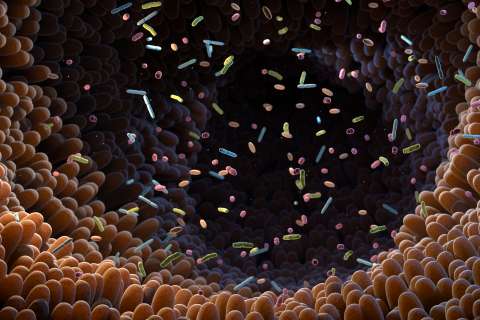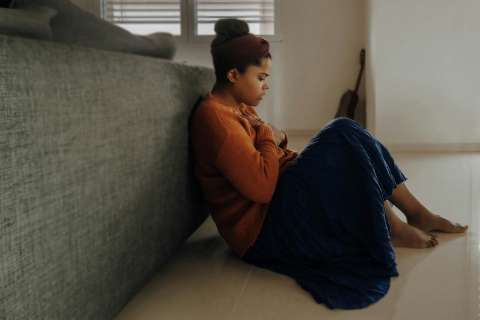By the time a minor with autism arrives at the Stewart and Lynda Resnick Neuropsychiatric Hospital at UCLA (RNPH), family members likely have run out of ways to cope with a child who harms herself or lashes out to express himself.
On the 4 West Unit of RNPH, a behavior analyst — who has joined forces with a team of doctors, nurses, social workers and several other specialists — is helping to create a calming, therapeutic environment for young patients on the autism spectrum, particularly those who are minimally verbal or might use behaviors such as grabbing, pushing or hitting to try to get their needs met.
“Resnick is one of only a few hospitals in the area that takes ASD (autism spectrum disorder) patients,” said Cheryl Umali, BCBA, a board-certified behavior analyst who began working on the unit in February 2022. “Other hospitals will say they don’t have the staff and capacity to deal with the challenges that an ASD patient might bring.”
Umali, who also treats patients on the adult units, said family members tend to experience the brunt of minors’ challenging behavior, which can include aggression toward themselves or others. As a result, relatives often feel reassured when they can entrust children to medical professionals who have strategies for dealing with behavior that can seem intractable or even dangerous.
Minors with autism are typically admitted after a medical screening exam and an initial psychiatric evaluation in the emergency room. A robust multidisciplinary team (composed of doctors, nurses, an occupational therapist and a recreational therapist and, in some cases, psychologists, an educational consultant, a speech therapist and the behavior analyst) assesses each patient’s biological and cognitive age. The children are placed in either the child unit, which includes eight beds for kids generally between ages 4 and 12, or the adolescent unit, which has 10 beds for patients 12 to 17.
Many of the young RNPH patients with autism have an additional psychiatric condition that can complicate care. These conditions might include attention deficit hyperactivity disorder, anxiety, depression, bipolar disorder or schizophrenia. Some of these disorders can be treated with medications, which can also help to address a patient’s autism-driven irritability or impulsivity.
During the pandemic, many children lost access to vital services in schools and in the community and regressed, adding to the burdens for caregivers.
Effective communication
“The most challenging and vulnerable patients we have are the nonverbal,” Umali said. “They communicate maybe with gestures. They might be self-harming.” Resnick Neuropsychiatric Hospital staff work hard to manage these behaviors compassionately and sensitively, Umali said.
“From the very beginning,” she added, “the staff is challenged with how to communicate effectively with this patient so that we can help to get their needs met. We do not want them to get upset or frustrated because of our inability to understand them. We are careful not to rely on just medication to calm them.”
The goal of inpatient treatment is stabilization, Umali said. Once patients have stabilized, they can begin to participate in therapeutic activities with occupational or recreational therapists, such as painting, drawing, making stuffed toys, playing a keyboard, dancing or playing games. These activities can bring much-needed sparks of joy.
“Even in a hospital, we endeavor to have children laughing and playing when they are able,” Umali said. “A goal is to get them out of their rooms and interacting with others. If they are not ready to come out, then we take the activities to them.”
The American Psychiatric Association describes autism spectrum disorder as “a complex developmental condition involving persistent challenges with social communication, restricted interests and repetitive behavior.” Although signs of autism can appear before a child reaches age 1, symptoms usually become more consistently evident by age 2 or 3.
Researchers have not found a cure for autism, but effective interventions can improve a child’s ability to become what doctors call “highly functioning.”
Data show that the need for such interventions is great. Continuing a trend, the prevalence of autism spectrum disorder in American children rose between 2018 and 2020, according to a report released in March 2023 by the Centers for Disease Control and Prevention. In 2020, an estimated 1 in 36 8-year-olds had autism, up from 1 in 44 in 2018. The prevalence was significantly higher in boys (4%) than girls (1%).
Researchers said the rise was especially dramatic among children who are Black, Latino and Asian or Pacific Islander. They added that the data might reflect improved screening, awareness and access to services among groups that have historically been underserved.
Catherine Lord, PhD, a professor of psychiatry at the David Geffen School of Medicine at UCLA, was quoted in a New York Times story about the report.
“I have a feeling that this is just more discovery,” Dr. Lord said. “The question is what’s happening next to these kids, and are they getting services?”
Science of learning and behavior
Forward-thinking hospitals such as UCLA RNPH, which recognize the importance of providing acute care for this population, are increasingly turning to behavior analysts to devise strategies for effectively providing such services. Applied behavior analysis, a therapy based on the science of learning and behavior, is commonly associated with treating children on the autism spectrum.
Behavior analysts, who must earn a master’s degree to qualify for board certification, focus on helping patients to build coping skills and to adapt to different environments.
Umali’s position is the first of its kind at UCLA’s inpatient psychiatric hospital. She said it came about because the nursing staff and hospital identified the critical need for greater support and effective treatments for patients with autism. Umali’s experience managing her own dyslexia and her four children’s learning differences helped to draw her to this kind of work.
Complexities abound for those working with minors who are on the autism spectrum, whose typical inpatient stay is at least two weeks.
“They’ll generally have school involved, along with a regional center and health providers,” said Jackie Agboke, a licensed clinical social worker who collaborates with Umali and others on the RNPH team. “They definitely require a lot more coordination of care, especially if they’re nonverbal and have more aggressive behaviors.”
Agboke coordinates the care for six or seven patients at a time. She was among those who cheered Umali’s arrival on the unit.
“We have a lot of kids on the autism spectrum with behavioral issues,” she said. “Our nursing staff is great but wasn’t always equipped to handle them. That’s where someone like Cheryl is so important. She’s helping to implement different strategies for the kids by asking: What are the triggers? What are helpful responses?”
Agboke cited the recent case of a patient whose aggressive behavior had led to a history of hospitalizations. He was minimally verbal and broke things. He couldn’t tolerate being in a dayroom with other kids.
Umali worked with the unit’s medical team to understand his communication needs and patterns or drivers of behavior. Before too long, he was finger painting and playing a keyboard with her. He became less aggressive. When he was ready to be released from the unit, Agboke met with the boy’s mother and doctor and contacted his school and a regional center (a nonprofit private corporation that contracts with the state to provide respite care or other services for individuals with developmental disabilities).
A few weeks ago, the mom emailed Agboke to say that her son was doing “pretty well.”
“Knock on wood,” Agboke said. “A good marker is usually that they don’t need to come back.”
Long-term strategies
Nurses who care for these patients find that there is no such thing as a typical day.
Each morning, “we hit the ground running,” said Lacey Ventura, RN, who typically works two or three 12-hour shifts each week. The kids are awake by 7:30 a.m. They hang out in their rooms until breakfast. During the rest of the day, they spend time in treatment programs with occupational and recreational therapists, nurses, Umali and doctors.

“It’s important to figure out their triggers and what works and what doesn’t,” Ventura said. “Structure is key. Cheryl has been key in speeding up that process of finding what works.
“We’re not just managing them but also creating long-term goals,” she added. “Cheryl gave us longer range on that. That’s something we were desperately lacking. She spends hours with families preparing them for what their lives will look like after discharge. I see families all the time who are panicking. She gives them that peace of mind to say: ‘We’ve got this.’”
Umali acknowledged that most patients will not experience a drastic change. “We aim to just get them back to their families stable enough to seek more support through outpatient community services,” she said. Change for many of these patients takes time, persistence and consistency.
“We’re not able to cure autism. We’re not even trying to change them much. We’re trying to honor the behaviors that are part of autism and provide intervention for the behaviors that are detrimental to the patient’s well-being. They just need to be understood. … We’ve got to give them some skills so that they can advocate for themselves.”
Martha Groves is the author of this article.




